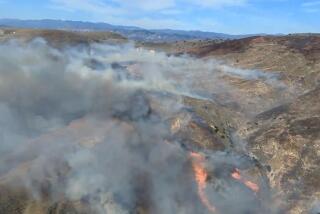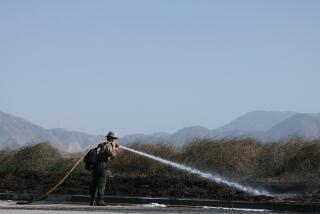Hope rises as winds begin to die
As fierce Santa Ana winds finally began to subside, firefighters reached a turning point Wednesday in their desperate four-day battle against Southern California’s wildfires. Although several large fires remained largely untamed and several communities threatened, the worst days of a terrible siege appeared to be over.
The toll by day’s end: 695 square miles burned and 1,609 homes destroyed, with damage estimated by the state Department of Insurance at more than $1 billion.
“We are making good progress,” said Tim Fike, a section chief with the Nevada City, Calif., Fire Department who was overseeing deployments of firefighters and equipment at the Grass Valley fire near Lake Arrowhead, one of 13 large blazes still burning in a seven-county area. “Our goal is to button it up as soon as possible.”
The firefighters got a big assist from the weather, as dust-dry, gale-force winds gave way to lighter breezes and some coastal humidity.
“Of course, there are challenges,” Fike said. “I could certainly use a few more hot-shot crews and some more bulldozers.”
President Bush declared a major disaster in the region, allowing fire victims to apply for federal grants for temporary housing, home repairs and low-cost loans to cover uninsured property losses.
The shortage of firefighting resources remained a constant theme, even as more aircraft flew into the region to join the effort.
Gov. Arnold Schwarzenegger sounded annoyed when he was asked by an ABC News reporter about complaints Tuesday from Orange County’s fire chief, Chip Prather, who said he could have squelched the destructive Santiago fire with more firefighting aircraft.
“Anyone who is complaining about the planes just wants to complain, because it is just a bunch of nonsense,” Schwarzenegger said. “The fact is, we have all the planes in the world here -- we have 90 aircraft here.”
The governor said planes had been grounded during crucial parts of the firestorm because of high winds.
The fire in Orange County, which destroyed nine homes, was a flash-point for anger not only because of Prather’s complaints, but because authorities believe that it was intentionally set. Investigators from the FBI and county agencies focused Wednesday on the intersection where the fire started, Santiago Canyon and Silverado Canyon roads.
“It’s definitely arson and it’s been deemed a crime scene,” said Jim Amormino, a spokesman for the Orange County Sheriff’s Department.
To the east, in San Bernardino County, a man who allegedly set a brush fire in Hesperia was arrested on suspicion of arson, and police reported shooting and killing another arson suspect after chasing him out of scrub behind Cal State San Bernardino.
Law enforcement officials said they did not know whether either of the men started any of the more than a dozen large fires that have devastated Southern California in recent days, including the nearby Lake Arrowhead blazes. The Hesperia fire was quickly extinguished by passersby.
In addition to the Santiago fire, a blaze in Temecula is suspected of being deliberately set. The causes of other fires remain under investigation, although at least three are believed to have been started when high winds knocked down power lines.
The confrontation that ended in the shooting death started about 6 p.m. Tuesday when university police spotted a man in a rural area of flood channels and scrub near the campus.
Officers tried to detain the man, but he got into his car and fled, ultimately driving up a dirt road into the foothills, authorities said.
“We don’t know whether he was an arsonist,” said Lt. Scott Patterson of the San Bernardino Police Department, which joined the pursuit. “What was related by the Cal State police was that they tried to contact him as a suspicious person in a brush area. Things being how they are, there was a suspicion that he could be an arsonist.”
The man, described only as a 27-year-old from Topock, Ariz, twice crashed his car and then tried to ram police vehicles, according to authorities. Both times, police responded by firing their weapons; the second time, the shots proved fatal.
There were other discordant notes amid the general mood of beleaguered optimism Wednesday. Six illegal Mexican immigrants were arrested by U.S. Border Patrol agents at Qualcomm Stadium after a report that they were stealing food and water meant for evacuees, agency spokesman Damon Foreman said.
Foreman said San Diego police, responding to a complaint from the evacuation center, found six people in a van who did not speak English. The police called the Border Patrol, which arrested the six, who were Mexican citizens and admitted stealing, Foreman said.
A volunteer at Qualcomm, Michael Turley, 28, said that Tuesday, he had spotted about a half-dozen people stealing supplies from the stadium and loading them into vehicles with Baja California license plates.
“It was a total slap in the face,” he said. “Here we had been volunteering and busting our butts, and people were taking all this.”
But all that was secondary to what was happening on the fire lines. By the end of the day, firefighters had reported significant containment of fires in Ventura County, Santa Clarita and Malibu. Among the fiercest firefights were those at Arrowhead and in San Diego County, where large areas remained under evacuation orders. Still, authorities said, the fires were not moving rapidly, and they expressed optimism that they could begin to gain control over them soon.
“Today I can finally say: It’s a good afternoon,” said San Diego County Sheriff Bill Kolender.
Near the front lines of the Harris fire, close to the Mexican border, officials said they were doing what they could with available resources, but still needed more.
California Department of Forestry and Fire Protection Capt. Scott McClean said calmer winds had helped the 1,200 firefighters on the front line.
But, he said: “Those 1,200 personnel are a little less than a third of what we need to fight a fire this big. They’re tired. . . . They’ve got a long road to go as well.”
George Broyles, a U.S. Forest Service spokesman, said wind conditions had improved enough to permit airplane and helicopters to make effective water and fire retardant drops. But, he said, competing winds from the east and west were creating swirling patterns in the fire zone, further complicating firefighting efforts.
Additional aircraft arrived Wednesday morning to help fight the Arrowhead and San Diego fires.
In addition to 47 aircraft already fighting the fires, forestry department officials agreed to allow 14 military water-dropping helicopters and C-130 aircraft to assist in San Diego.
Help also has come from Mexico, which has provided firefighters and electricity to the San Diego area. Mike Niggli, chief operating officer of San Diego Gas & Electric, said a major power transmission line had been restored after being knocked out of service. Its loss had left the area critically short of electricity.
Three more deaths were reported Wednesday that were related in some way to the fires.
A resident of a Carlsbad nursing home became the fifth evacuee to die, the San Diego County medical examiner’s office said. James Sharp, 64, died of undetermined causes Tuesday night, one day after being evacuated from his nursing home to Alvarado Hospital.
In Los Angeles County, authorities said a truck driver who took a Malibu road that is off limits to heavy trucks lost control Wednesday and struck two cars, killing himself and another driver and injuring a Los Angeles County firefighter. The trucker was apparently on a steep part of Kanan Dume Road because his usual route was closed by fire, Sheriff’s Sgt. Ken Scheurn said.
The official death toll is one; eight other deaths have been linked to the fires. Sixty-four people have been injured.
Also Wednesday, the San Diego Wild Animal Park reported its first two fire fatalities: a clapper-rail bird and a Kiang, a member of the horse family originally from Tibet. The suspected cause is smoke inhalation.
The rest of the 3,500 animals survived without injury, a park spokesman said.
President Bush plans to visit Southern California for about three hours today, touring the region aboard the Marine One helicopter, then visiting a fire-damaged community. He also plans to meet with state, local and federal officials, and lunch with emergency workers.
Bush met at the White House on Wednesday with his Cabinet and afterward told reporters: “I believe the effort is well coordinated. I know we’re getting the manpower and assets on the ground that have been requested by the state and local authorities.”
Speaking in the Cabinet Room, the president said Schwarzenegger told him that the state was receiving the federal help it needed.
“I assured him that if he needs anything, then, great, we’ll provide it, we’ll do so,” he said.
Also Wednesday, California Insurance Commissioner Steve Poizner eased regulations to let insurance companies bring more personnel from out of state to speed the handling of thousands of claims from the Southern California wildfires.
And the Los Angeles County assessor’s office announced that property owners whose homes have suffered at least $10,000 in damage can notify the assessor’s office to receive a corrected tax bill or refund this tax year.
mitchell.landsberg
@latimes.com
Times Staff Writers Tami Abdollah, Andrew Blankstein, Ari B. Bloomekatz, Rich Connell, James Gerstenzang, Scott Glover, Anna Gorman, Christine Hanley, Molly Hennessy-Fiske, Jack Leonard, Rong-Gong Lin II, Robert J. Lopez, Richard Marosi, David McKibben, Joe Mozingo, Sonia Nazario, Charles Ornstein, Tony Perry, Alex Pham, David Pierson, Maeve Reston, Francisco Vara-Orta and Richard Winton contributed to this report.
More to Read
The biggest entertainment stories
Get our big stories about Hollywood, film, television, music, arts, culture and more right in your inbox as soon as they publish.
You may occasionally receive promotional content from the Los Angeles Times.








